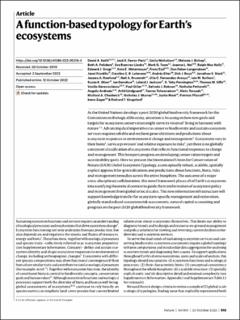| dc.contributor.author | Keith, David A. | |
| dc.contributor.author | Ferrer-Paris, José R. | |
| dc.contributor.author | Nicholson, Emily | |
| dc.contributor.author | Bishop, Melanie J. | |
| dc.contributor.author | Polidoro, Beth A. | |
| dc.contributor.author | Ramirez-Llodra, Eva | |
| dc.contributor.author | Tozer, Mark G. | |
| dc.contributor.author | Nel, Jeanne L. | |
| dc.contributor.author | Mac Nally, Ralph | |
| dc.contributor.author | Gregr, Edward J. | |
| dc.contributor.author | Watermeyer, Kate E. | |
| dc.contributor.author | Essl, Franz | |
| dc.contributor.author | Faber-Langendoen, Don | |
| dc.contributor.author | Franklin, Janet | |
| dc.contributor.author | Lehmann, Caroline E. R. | |
| dc.contributor.author | Etter, Andrés | |
| dc.contributor.author | Roux, Dirk J. | |
| dc.contributor.author | Stark, Jonathan S. | |
| dc.contributor.author | Rowland, Jessica A. | |
| dc.contributor.author | Brummitt, Neil A. | |
| dc.contributor.author | Fernandez-Arcaya, Ulla C. | |
| dc.contributor.author | Suthers, Iain M. | |
| dc.contributor.author | Wiser, Susan K. | |
| dc.contributor.author | Donohue, Ian | |
| dc.contributor.author | Jackson, Leland J. | |
| dc.contributor.author | Pennington, R. Toby | |
| dc.contributor.author | Iliffe, Thomas M. | |
| dc.contributor.author | Gerovasileiou, Vasilis | |
| dc.contributor.author | Giller, Paul | |
| dc.contributor.author | Robson, Belinda J. | |
| dc.contributor.author | Pettorelli, Nathalie | |
| dc.contributor.author | Andrade, Angela | |
| dc.contributor.author | Lindgaard, Arild | |
| dc.contributor.author | Tahvanainen, Teemu | |
| dc.contributor.author | Terauds, Aleks | |
| dc.contributor.author | Chadwick, Michael A. | |
| dc.contributor.author | Murray, Nicholas J. | |
| dc.contributor.author | Moat, Justin | |
| dc.contributor.author | Pliscoff, Patricio | |
| dc.contributor.author | Zager, Irene | |
| dc.contributor.author | Kingsford, Richard T. | |
| dc.date.accessioned | 2023-03-10T10:38:21Z | |
| dc.date.available | 2023-03-10T10:38:21Z | |
| dc.date.created | 2022-10-31T12:03:26Z | |
| dc.date.issued | 2022 | |
| dc.identifier.citation | Nature. 2022, 610 513-518. | en_US |
| dc.identifier.issn | 0028-0836 | |
| dc.identifier.uri | https://hdl.handle.net/11250/3057658 | |
| dc.description.abstract | As the United Nations develops a post-2020 global biodiversity framework for the Convention on Biological Diversity, attention is focusing on how new goals and targets for ecosystem conservation might serve its vision of ‘living in harmony with nature’1,2. Advancing dual imperatives to conserve biodiversity and sustain ecosystem services requires reliable and resilient generalizations and predictions about ecosystem responses to environmental change and management3. Ecosystems vary in their biota4, service provision5 and relative exposure to risks6, yet there is no globally consistent classification of ecosystems that reflects functional responses to change and management. This hampers progress on developing conservation targets and sustainability goals. Here we present the International Union for Conservation of Nature (IUCN) Global Ecosystem Typology, a conceptually robust, scalable, spatially explicit approach for generalizations and predictions about functions, biota, risks and management remedies across the entire biosphere. The outcome of a major cross-disciplinary collaboration, this novel framework places all of Earth’s ecosystems into a unifying theoretical context to guide the transformation of ecosystem policy and management from global to local scales. This new information infrastructure will support knowledge transfer for ecosystem-specific management and restoration, globally standardized ecosystem risk assessments, natural capital accounting and progress on the post-2020 global biodiversity framework. | en_US |
| dc.language.iso | eng | en_US |
| dc.publisher | Nature | |
| dc.rights | Navngivelse 4.0 Internasjonal | * |
| dc.rights.uri | http://creativecommons.org/licenses/by/4.0/deed.no | * |
| dc.title | A function-based typology for Earth’s ecosystems | en_US |
| dc.title.alternative | A function-based typology for Earth’s ecosystems | en_US |
| dc.type | Peer reviewed | en_US |
| dc.type | Journal article | en_US |
| dc.description.version | publishedVersion | en_US |
| dc.source.pagenumber | 513-518 | en_US |
| dc.source.volume | 610 | en_US |
| dc.source.journal | Nature | en_US |
| dc.identifier.doi | 10.1038/s41586-022-05318-4 | |
| dc.identifier.cristin | 2066713 | |
| cristin.ispublished | true | |
| cristin.fulltext | original | |
| cristin.qualitycode | 2 | |

